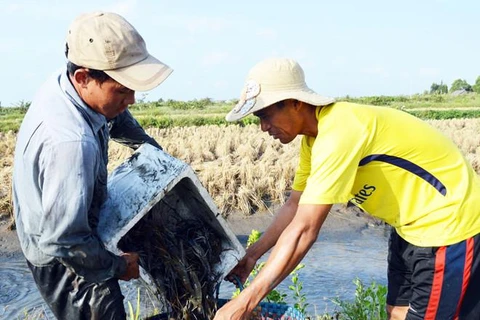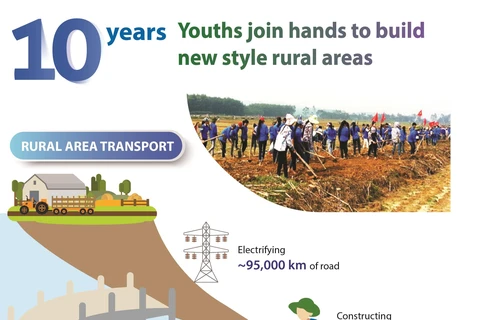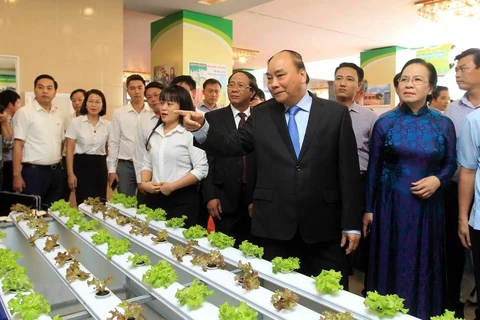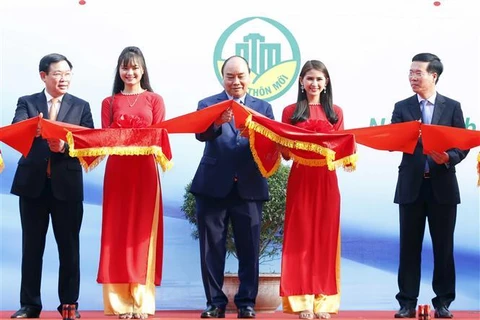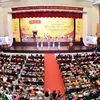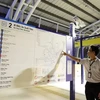 Prime Minister Nguyen Xuan Phuc (standing) speaks at the national conference held in Nam Dinh province on October 19 (Photo: VNA)
Prime Minister Nguyen Xuan Phuc (standing) speaks at the national conference held in Nam Dinh province on October 19 (Photo: VNA) Nam Dinh (VNA) – A national conference was held under the chair of Prime Minister Nguyen Xuan Phuc in the northern province of Nam Dinh on October 19 to review 10 years implementing the national target programme on new-style rural areas.
At its seventh session in August 2008, the 10th-tenure Party Central Committee issued Resolution No. 26 on agriculture, farmers and rural areas.
This resolution set the target that material and spiritual lives of rural residents will be unceasingly improved, with faster progress in disadvantaged areas. Besides, agriculture will be developed towards commercial production and high productivity, quality, effectiveness and competitiveness that can firmly ensure national food security in both short and long terms.
It also aims to build new-style rural areas with modern socio-economic infrastructure, with 50 percent of all the communes to be recognised as new-style countryside by 2020.
To realise this resolution, the Government approved a national target programme on building new-style rural areas for 2010 – 2020. It also launched an emulation movement calling on the whole nation to join hands in the work.
Statistics show that thanks to efforts by the whole political system and society, great achievements have been obtained over the past decade.
Notably, the new-style countryside building target has been reached almost two years ahead of schedule. As of October 2019, 4,665 communes or 52.4 percent of the total nationwide have been recognised as new-style rural areas, 2.4 percent higher than the target set for 2020. Among them, 63 communes have satisfied advanced criteria.
Eight provinces and centrally-run cities have had all of their communes winning the recognition, namely the provinces of Nam Dinh, Ha Nam, Hung Yen, Thai Binh, Dong Nai and Binh Duong, and the cities of Da Nang and Can Tho.
Meanwhile, 109 district-level localities in 41 provinces and cities have gained the title.
In particular, with all of their communes and district-level localities meeting all criteria, Dong Nai in the south and Nam Dinh in the northern region have completed the task.
The annual per capita income in rural regions rose three-fold, from 12.8 million VND (over 550 USD at the current exchange rate) in 2010 to 35.9 million VND in 2018. The income gap between rural and urban areas also dropped from 2.1 times to 1.8 times during the period. The household poverty rate in those areas has also declined sharply, by about 1.5 percent each year on average.
Rural socio-economic infrastructure has been improved considerably, thus gradually meeting people’ daily and production needs and keeping up with local development demand. After more than nine years, over 206,740km of rural roads have been constructed or upgraded across the country.
Additionally, cultural and social aspects have received more attention. The rate of collected solid waste has been increasing, from 44.1 percent in 2011 to 63.5 percent at present.
Over the last nine years, more than 2.4 quadrillion VND have been mobilised for building new-style countryside, with 27.7 percent from the State budget, 57.6 percent from loans, 4.9 percent contributed by businesses, and 9.8 percent donated by people.
Aside from reviewing the 10-year programme implementation, the conference on October 19 was also meant to set up orientations and tasks for carrying out the work in the years to come.
Prior to this event, a ceremony was held on October 18 to honour prominent collectives and individuals in the work between 2010 and 2020. On this occasion, PM Phuc also launched an emulation movement on building new-style rural areas for 2021 – 2025./.
VNA
